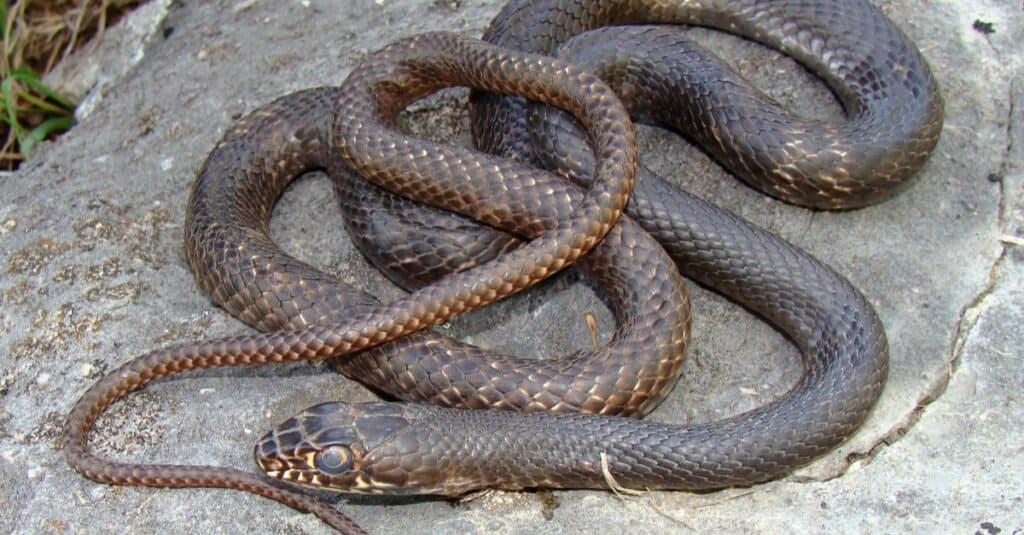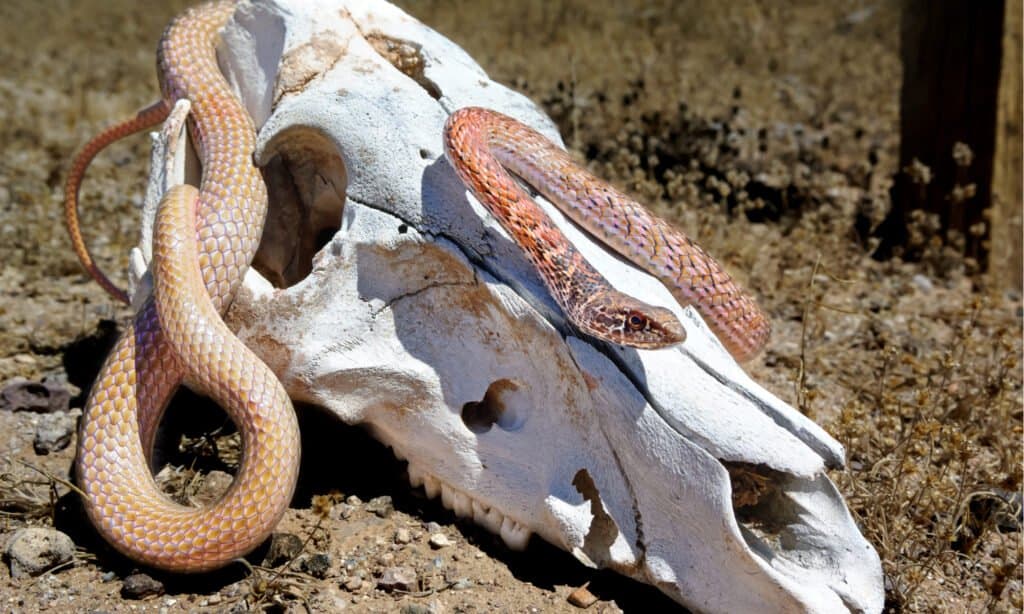When it comes to coachwhip snakes, you’ll hear a lot of talk about western or eastern coachwhips. This leaves one to wonder what exactly are the differences when it comes to a western vs eastern coachwhip snake?
The answer is not much.
Coachwhip snakes are all the same species and have a lot of similar characteristics. There are 6 different kinds (subspecies) of coachwhip snakes in the United States and Mexico, and all are nonvenomous.
The other 4 that we aren’t bringing to the table today are the Baja California coachwhip, the Sonoran coachwhip, the San Joaquin coachwhip, and the red coachwhip.
Coachwhips are known to inhabit northern Mexico and the southern United States from the Pacific to the Atlantic. The specific ranges of the western vs eastern coachwhip do vary slightly.
Important Differences with a Western vs Eastern Coachwhip Snake

Western coachwhip snakes are a little more heat tolerant than eastern coachwhips.
©Alexander Wong/Shutterstock.com
When it comes to the western vs eastern coachwhip snake, there are 3 differences:
- Western coachwhips tend to be brownish while eastern coachwhips are greenish.
- Western coachwhips are a little more heat tolerant than eastern coachwhips.
- The two snakes have differing natural ranges.
Since coachwhips refer to a species, there isn’t much of an innate differentiation to be made when it comes to general diet, behavior, habitat preferences, and reproduction. What does differentiate these snakes is their locale, which determines their coloration and the specific prey that they consume.
So, when a comparison is being made between these two snakes, it’s like comparing dog breeds. While it is possible to distinguish in detail between the two animals, they are both inherently dogs. There is also the possibility of a myriad of mixed animals in between, just like with coachwhip snakes.
Why are the western vs eastern coachwhip snakes considered part of the same species? It’s because they’re able to interbreed and create viable offspring that makes them almost the same instead of close relatives.
Western vs Eastern Coachwhip Snake: Natural Ranges
Eastern coachwhips live from Missouri to Florida between Texas and the Atlantic Ocean. The western coachwhip lives from Mexico City to Nebraska. Their territories vary a bit in each direction, but they have a large overlapping range.
Western and eastern coachwhips also share overlapping territories with other members of their species though they generally don’t compete for resources.
Strangely, coachwhip snakes aren’t found around the Mississippi River. It’s safe to assume that a coachwhip that’s west of the Mississippi is a western coachwhip while snakes east of the river are eastern coachwhips. This isn’t always the case, but it’s a good rule of thumb.
Western vs Eastern Coachwhip: Color as Adults

The heads of coachwhip snakes are darker than their tails.
©Matt Jeppson/Shutterstock.com
The western coachwhips tend to be black or reddish while the eastern coachwhips are brown, black, or greenish. Both are darkest at their head with a color gradient running to their tail. Their tails are always light, like a tan or pinkish.
Juveniles are more likely to have black or colored banding and spots which fade as they get into adulthood. Some have a white dot on their head that fades over time. While most adults don’t have banding or spots like the juveniles, some do.
Coachwhips get their name from their scaling which resembles the cross-hatched pattern of an old whip used to wrangle horses. All coachwhips have smooth scales and slender bodies. They can grow to be 8 feet long.
Western vs Eastern Coachwhip: Preferred Wild Habitat
Eastern coachwhips like to live in open grasslands and will also thrive in meadows and swamps. Western coachwhips also like open habitats like dunes, scrublands, and fields. Their exact favorite locations depend on which population of snakes we’re discussing and where they are located. Even coachwhip snakes separated by 50 miles can have different lifestyles.
Rocks aren’t needed for coachwhips as they’ll hide in ground litter or shrubbery. They’re not fans of the water, but they do know how to swim if a situation necessitates it. They’ve even learned how to make a home in the suburbs by adapting to open lots, medians, and verges.
You might see a coachwhip in your garden, especially if you live in the eastern United States where the eastern coachwhips reside. They will flee before they attack, and they’re great snakes to have around because they control the pest population. Their juveniles help take care of insects while the adults will go for the mice, rats, and bird eggs.
Western vs Eastern Coachwhip: Preferred Pet Enclosure

It is not recommended that coachwhip snakes be kept as pets.
©Deep Desert Photography/Shutterstock.com
It’s not recommended that coachwhip snakes be kept as pets. They rarely acclimate to being handled and are notorious biters. They don’t warm up well to the captive-bred diet and may starve themselves if caught in the wild. Since people don’t really keep them as pets, there aren’t many captive-bred options out there.
These snakes may be thin but they’re huge at 8 feet long. It’s recommended that enclosures be twice the length of your snake, so housing a coachwhip its entire life is tricky.
Since most coachwhip snakes are caught in the wild, it’s best you know exactly where the snake was sourced. This will help you determine the kind of enclosure you should build. In general, these snakes are out during the hottest part of the day, so you’ll want to simulate that for them. You’ll also want to give them a burrow to hide in.
If you have a western coachwhip from the Sonoran Desert, you’ll want to give it the heat and soil to which it is accustomed. If you have an eastern coachwhip from Florida, you’ll want to plan its vivarium appropriately.
The photo featured at the top of this post is © Matt Jeppson/Shutterstock.com
Discover the "Monster" Snake 5X Bigger than an Anaconda
Every day A-Z Animals sends out some of the most incredible facts in the world from our free newsletter. Want to discover the 10 most beautiful snakes in the world, a "snake island" where you're never more than 3 feet from danger, or a "monster" snake 5X larger than an anaconda? Then sign up right now and you'll start receiving our daily newsletter absolutely free.
Thank you for reading! Have some feedback for us? Contact the AZ Animals editorial team.






